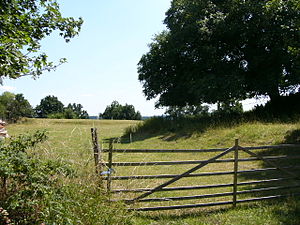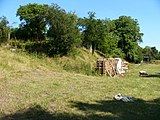Absberg Castle
| Absberg Castle | ||
|---|---|---|
|
Neck ditch with ascent to the castle hill |
||
| Creation time : | 1349 | |
| Castle type : | Niederungsburg, tower hill castle | |
| Conservation status: | Traces of terrain, hardly any remains of the wall | |
| Standing position : | Knighthood | |
| Construction: | nothing special | |
| Place: | Absberg | |
| Geographical location | 49 ° 8 '36.9 " N , 10 ° 52' 48.1" E | |
| Height: | 460 m above sea level NN | |
|
|
||
The castle Absberg was the fortress of a motte in Absberg . Absberg is now a market in the central Franconian district of Weißenburg-Gunzenhausen in Bavaria .
History of the Absberg castle complex
Previous buildings
The first small mansion in Absberg, on a hillside below the present-day through-road, was first handed down in 1343, but it was undoubtedly older; the Absberg family can be traced back to 1238. In 1349 the knight Goswin von Absberg received the (subsequent?) Permission from Emperor Karl IV to build a castle. In 1372 Absberg received market rights. The seat near the church and the market square was destroyed in the Third City War in 1449 and, after a reconstruction, again in 1461 by the incursion of Ludwig the Rich into margravial territory under Albrecht Achilles .
Largest castle complex
The reconstruction then took place further east to the largest castle complex of the Absberg family.
In the early 16th century, the robber baron Hans Thomas von Absberg kidnapped merchants on their trade trips and demanded a large ransom for their release. He looked for allies who would support him in his raids, on whose castles he could take refuge in case of danger and where he could hide his hostages. In 1523 the Swabian Federation finally sent its troops to level a total of 23 "predatory nests" to the ground. The federal troops, which consisted of 10,000 foot soldiers and 1,000 horsemen, carried 100 cannons and 30 rifles as armament, for which they had 900 quintals of black powder with them. They reached Absberg Castle on July 22, 1523 and completely destroyed it to prevent the Absbergers from returning.
At the time of the destruction, Hans Thomas's father was sitting in the castle, trying to distance himself from his son's activities. A part that was preserved was still used as temporary accommodation.
Transfer to the Teutonic Order
It was not until Hans Thomas' grandson, Hans Konrad von Absberg, that he established a more modest new seat in the market near today's Teutonic Order Castle between 1593 and 1595. In 1610 it was expanded. In 1647 the Absberg family died out with Hans Veit von Absberg. After several years of dispute with the heirs, the property fell to the Teutonic Order in 1652 . He demolished the residence and built today's Absberg Castle from 1723 to 1726 .
The woodcut by Hans Wandereisen
Main article: Wandereisen woodcuts from 1523
The later colored and inscribed woodcut by Hans Wandereisen says: XXII. Asperg belonged to Mr. Hanns Jorgen from Asperg / Is burned from the Schwebischenn Bundt. • 1523 •
On the woodcut you can see the extensive castle complex rising on a mountain above the village. Tower and building systems are drowning in a sea of flames: roof beams have collapsed, buildings have deep cracks in the masonry. There are two entrances to the main castle . The entrance closer to the village is additionally secured by a crenellated gatehouse in front . The main castle is reinforced by a massive curtain wall with a covered battlement and defensive towers , the buildings behind it are depicted crowded and covered by flames. In the foreground, two riders stand opposite each other in a square, with the left rider, apparently a captain , repeated as a motif in numerous other woodcuts. Left behind half-timbered houses and the church with its round tower, the oversized cavalry of the Federation with spears and a flag of the Federation. On the flag there is a coat of arms with the St. Andrew's cross in silver and red. To the right behind a fenced single half-timbered building stand the foot troops , also armed with spears and with another bunch of flags with red and white stripes.
The current state of the castle from 1523
Contrary to the expected distances of the woodcut, the castle is only a few meters from the village. The terrain descends all the way down to the Brombachsee . The castle rises on a mountain spur in front of it , but lies lower than the village. A wide ditch shields the castle from the village side. You can also see the castle hill, the "Pfarrbuck", which shows the work done by human hands. The wall on the far right of the woodcut could still be partially preserved in the ground, but the section is heavily overgrown. There have not yet been any excavations.
The area is designated as a soil monument (D-5-6831-0084) by the Bavarian State Office for Monument Preservation (BLfD) .
literature
- Helmut Rischert: The castles in the Anlautertal (2). In: Collective sheet of the historical association Eichstätt 76 (1983), Eichstätt 1984, esp. P. 14f. (Von Absberg family).
- Thomas Steinmetz: Conterfei a number of acts of war from 1523 to 1527 Jar - to representations of castles about the "Absberg feud" or the "Franconian War" . In: Contributions to the exploration of the Odenwald and its peripheral landscapes IV . Breuberg-Neustadt 1986. pp. 380f.
- Walter Bauer (ed.): Absberg - a thousand-year history . Wendelsheim 1993.






